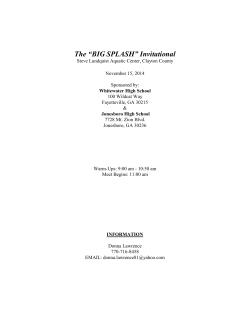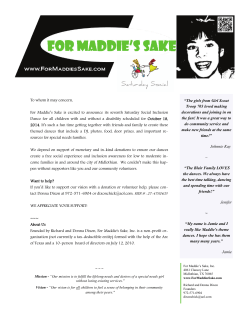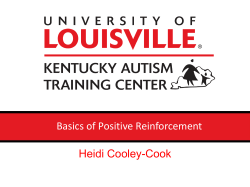
Stop the Volcano! …or How to Cap the Eruption
Stop the Volcano! …or How to Cap the Eruption Donna M. Eskut Behavior Support Teacher Fayette County, Georgia eskut.donna@mail.fcboe.org 404-428-2911 Presented by Donna Eskut IDEA Conference June 2012 1 Table of Contents Escalation Cycle Positive and Proactive Behavior Management Questions to Help Determine the Functions of Behavior Differentiating Instruction - Manage Behavior Problem Solving when a Child is in Crisis Guidelines for Working with Students in a Classroom Thoughts to Ponder Presented by Donna Eskut IDEA Conference June 2012 3 4 5 7 10 11 12 2 Escalation Cycle Stage 1: Calm Student is at baseline – Everyone is different – What does “calm” look like? Triggering event – Learn student’s triggers/antecedents – Don’t assume Able to exhibit behaviors to succeed in class Stage 2: Triggers (Antecedents) “What is different from baseline?” – Internal signs School based and non-school based – External signs/ behaviors Active and inactive – Body prepares for fight or flight Stage 3: Crisis! (Behavior) CRISIS!!! – Different for everyone (aggression vs. hide) – Goal: Keep child/others safe – Must have a plan! – Not a time for teaching or processing – No demands Presented by Donna Eskut – Do not payoff/ “feed in”: Remove attention – Fake busy but don’t ignore the student – Look for opportunities to catch child being calm Stage 4: De-escalation Body calming/ returning to normal levels Acknowledge calm (“small cookies”) “Ready” test: Body, face, voice, simple compliance Not a time for debriefing with student Know that cycle can begin again if not “ready” Stage 5: Recovery Depends on level of intensity of crisis behavior Sleep/making amends/cleaning up Label the positive – “I like how you…”/ Not the negative Caring, but not condoning crisis Flexibility with student schedule following escalation Make a plan to debrief with student and staff during a neutral time IDEA Conference June 2012 3 Positive and Proactive Behavior Management A 5:1 ratio of positive to negative interactions Classroom expectations and rules developed and taught Transition procedures taught Classroom routines taught directly Active supervision constantly implemented in all settings Minor problems addressed quickly and efficiently Chronic problems anticipated and pre-corrected Presented by Donna Eskut IDEA Conference June 2012 4 QUESTIONS TO HELP DETERMINE THE FUNCTION OF BEHAVIOR ADULT ATTENTION • • • • • • • What do you (or other staff) do (reliably) when the behavior happens? How do you react to the behavior? What do you say or do after the behavior occurs? Does the behavior stop after you or staff react? Do you or staff react in the same manner with other behaviors (either appropriate or inappropriate)? If so, what behaviors? Are these other behaviors more efficient and/or effective in getting you or staff to react in desired fashion? What behavior is more likely to get you to react in this manner? PEER ATTENTION • • • • • What do peers in the natural environment do when behavior happens? Do peers reliably react to this behavior in this fashion? Is the peer reaction immediate or delayed? Is this a behavior that is encouraged by peers in the classroom? In what ways is it encouraged? Is the student desirous of a certain peer’s or peers’ attention? TANGIBLE REINFORCER • • • • • Is the child given anything after behavior commences (to get him to stop)? Is the student desirous of this activity or item at this time? How long does the child do the behavior before the item or activity is given? Is there a chain of behaviors that leads up to the student getting some item or activity? Are there times when this item or activity is available during the day, and, if so, does the child desire the item or activity then? SENSORY REINFORCER • • • What is the natural result (consequences) of that behavior? What happens immediately (within a split second) in a physical sense, when the behavior occurs (e.g., what sound, visual display, tactile involvement, etc.)? Does the behavior occur independent of social context (i.e., when alone)? Presented by Donna Eskut IDEA Conference June 2012 5 ESCAPE OF INSTRUCTION-TASK DURATION • • • • • Does the behavior occur during lengthy periods of oral (teacher delivered) instruction? Does it occur during seatwork that is lengthy (relative to the child)? Does the behavior become more frequent the longer the student has to continue working at his/her seat or listening to the teacher provide instruction? Is the behavior less likely to occur if the instructional period is short for some reason? Does it coincide with the student’s increasing level of off-task behavior and/or non-attending behavior? ESCAPE OF INSTRUCTION-TASK DIFFICULTY • • • Does the behavior occur when the child is given material that is difficult for him/her? Is the behavior less likely with easy material (or easy subjects/content?) Does the level of behavior escalate the longer the child remains in the instructional setting with difficult material? ESCAPE OF SOCIAL SITUATIONS • • • Is anything (an activity, an object, another person) removed or terminated when this behavior occurs? Does the behavior serve to avoid an unpleasant social activity? Under what antecedent conditions is this function likely to occur? Presented by Donna Eskut IDEA Conference June 2012 6 Differentiating Instruction MANAGE BEHAVIOR The key to managing behavior is providing an environment where behavior problems are less likely to occur. Be proactive and prepared. It is much easier to prevent problems than it is to remediate them. Refer to individual Behavior Intervention Plan when appropriate. 1. Clearly define limits A. Review procedures daily…or even hourly B. Post rules in a prominent place (3-5 rules total). C. Make rules simple, positive and specific. D. Tie following the rules to consequences: both positive and negative. E. Teach the rules to student. Don’t assume they understand the rules. F. Try verbal or written contracts for student who breaks rules frequently. G. Involve parents of student so they understand the behavioral expectations of school and can encourage similar limits at home. H. Provide clear physical limits and / or academic expectations. 2. Frequent reminder of rules A. Explain and demonstrate rules. B. Give prompts or cues for appropriate behavior. C. Role-play rules. D. Provide ample opportunities for rules to become habit. 3. Positive reinforcement / concrete reinforcement A pat on the back or a comment about work well done can have a huge effect upon the self-esteem and performance of a student with learning disabilities. Concrete reinforcement refers to things such as food, cakes, and prizes. Most students benefit more from other reinforcers such as attention, praise, and activities. Some students need concrete reinforcers. Some examples include: A. Stickers B. A nice comment on the student’s paper C. Special Award D. Special pens or pencils 4. Frequent eye contact / proximity control A. Establish eye contact while giving directions and reinforcement. B. Maintain eye contact to gain compliance. C. Continue eye contact to keep student focused. D. Remain close to student to anticipate problems that may occur. E. Reinforce student in close proximity. Reinforcement should be subtle. F. One word reminders or cues from across the room. Presented by Donna Eskut IDEA Conference June 2012 7 5. Frequent breaks A. Build breaks or movement into the class period to avoid loss of attention. B. Allow breaks when material is new of different. C. Assign active student special activities which require movement (errands, messages, etc.) D. Change activities frequently (10-15 minute per session). E. Provide time for student to get organized. 6. Private discussion regarding behavior A. Be direct and specific while discussing behavior. B. Remain calm during discussion. C. Remind student of rules. D. Explain consequences. E. Provide opportunity for student to improve behavior. F. Problem solving/ Four step counseling model 7. In class time out A. Restrict reinforcers for a short time. B. Sit the student a few feet away from the work setting, able to observe but unable to earn reinforcement (participation) for a short period of time. C. Remove student to an isolated part of the room where he is unable to see. D. Use a reasonable amount of time for each time out episode (a minute or less per year of age of the student). E. Require student to complete activity missed as a result of time out. Remember! Time out is a procedure that temporarily excludes a student from the opportunity to receive reinforcement. It should serve a purpose and not just used to punish students. 8. Opportunity to help teacher A. Allow student to pass out materials, run errands, clean and organize teacher’s materials, tutor peers, prepare assignments, buddy with a younger peer, create a bulletin board, teach a lesson, drill facts. 9. Supervision during transition activities A. Walk next to student (proximity control). B. Remain within eye distance of student. C. Remain with student until another adult arrives. D. Allow student to leave or arrive a few minutes prior to classmates with supervision at all times. 10. Avoid strong criticism / confrontation A. Focus on positive student behavior. B. Use humor when appropriate. C. Reinforce student for attempts toward responsible behavior. D. Discuss behavior at appropriate time and place (be discreet). Presented by Donna Eskut IDEA Conference June 2012 8 11. Conference with parents A meeting with the parent, teacher, and student can become a positive action toward improvements in the classroom. A. B. C. D. E. F. Keep daily or weekly contact with parents. Provide parents with specific observable behaviors of student. Log contact or attempted contact with parents. Inform parents of behavioral expectations of school. Document behavior in writing. Duplicate communication with parents. (Notes home or e-mails.) Presented by Donna Eskut IDEA Conference June 2012 9 Problem solving (when child is in crisis/problem): 1: I see that you are (physical characteristics/actions). 2: Are you (list a feeling…after 2 attempts go ahead and process)? 3: Who has upset you? What happened to upset you? When did this happen? Where did this take place? How did that happen? NEVER ASK WHY! It is judgmental! 4: How could you solve this? If not a reasonable solution…WHAT ELSE could we do? Presented by Donna Eskut IDEA Conference June 2012 10 Guidelines for Working with Students in a Positive, Proactive Classroom Move slowly and deliberately toward the problem situation. If possible, provide some on-task interactions with other students on the way to the target situation. Speak privately Speak calmly. Use flat, controlled voice—matter-of-fact; do not threaten Minimize body language. Avoid pointing, staring at, or crowding the student Keep reasonable distance. Speak respectfully. Use student’s name and speak in a soft, detached and respectful manner. Establish eye-level position. If students are sitting then sit beside them or squat beside them if possible. Be brief. Use language that is brief and simple. Stay with the agenda. Avoid power struggles. Stay focused on the problem at hand. Do not be drawn into, “I won’t—you will” types of power struggle engagements. Acknowledge cooperation. Withdraw if the situation escalates. Withdraw from student and follow school emergency procedures. Presented by Donna Eskut IDEA Conference June 2012 11 THOUGHTS TO PONDER Discipline is a Process, Not an Event Discipline is determined mainly by insights, not incidents. When you know that a student is likely to have a problem, intervene so he won’t. April, a kindergartner, grew up alone. When she entered school, she was simply fascinated with other children. To get their attention, she grabbed kids around their necks at recess, all the while smiling. When she clutched at them kids called her “the mean girl,” and at first we agreed. They screamed and she was punished. No one was getting anywhere. Finally we changed our approach. “April, are you trying to play with that girl?” we asked. “Here’s how you touch when you want to play,” we said. We then asked another child to show April how. When she was no longer seen as mean, other kids rallied to her—helping her learn to play. We all just needed to understand differently. (L. Tobin, 1998) Teach kids that they can affect their world. That is the most important thing of all. Students who cannot or who believe they cannot become very skilled at making it appear that they will not. Many teachers who encounter a difficult child expect too much change too soon. List the behaviors you want to change. If you improved one behavior a week would it really take so long? The more severe the consequence, the less likely it will be consistently applied. You’ll hesitate, then wait until your level of frustration matches the severity of the consequence. Reasonable, consistent, incremental consequences help you avoid growing angry. The most powerful rewards are not the earned rewards—they are expected. The most powerful rewards are the unexpected ones because they reward a child not for what he has done, but simply for who he is. Think about how much time a troubled child already takes up in your day—the total time you spend correcting and redirecting and disciplining him. Twenty-five minutes out of every morning, maybe more? If each day you scheduled five minutes of quality time with him, wouldn’t the result be a net gain for everyone? Give discouraged students one task that makes them feel important. One clear reason for them to walk in the door. When a middle school student lacks social skills, what have we been teaching him for eight years that was more important than how to make friends? Children tire of adults who give directions without providing directions. Presented by Donna Eskut IDEA Conference June 2012 12
© Copyright 2025





















